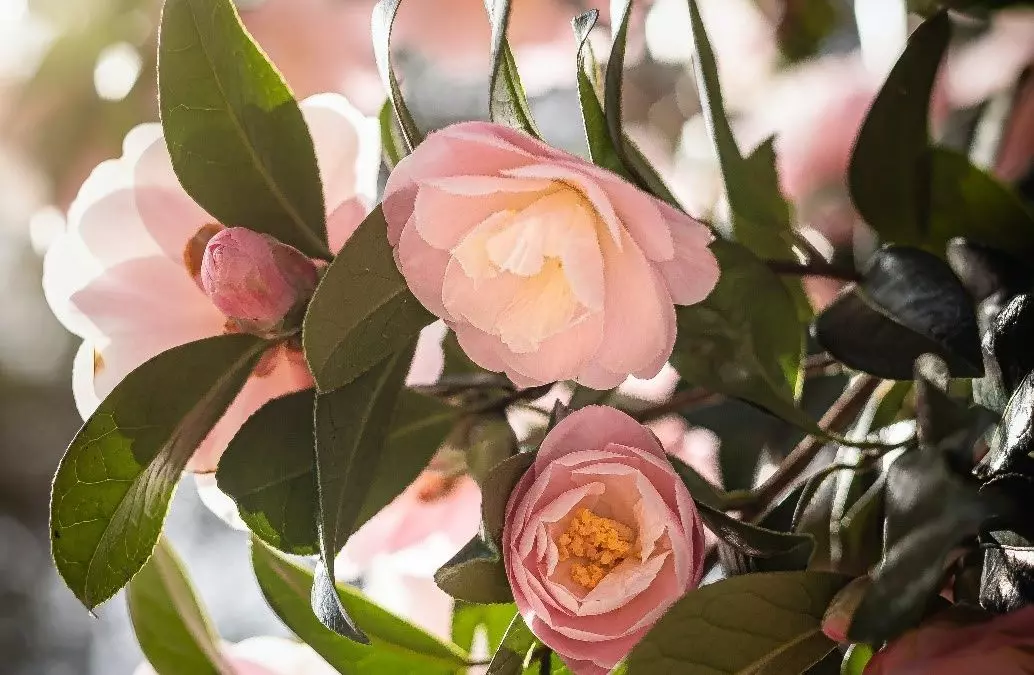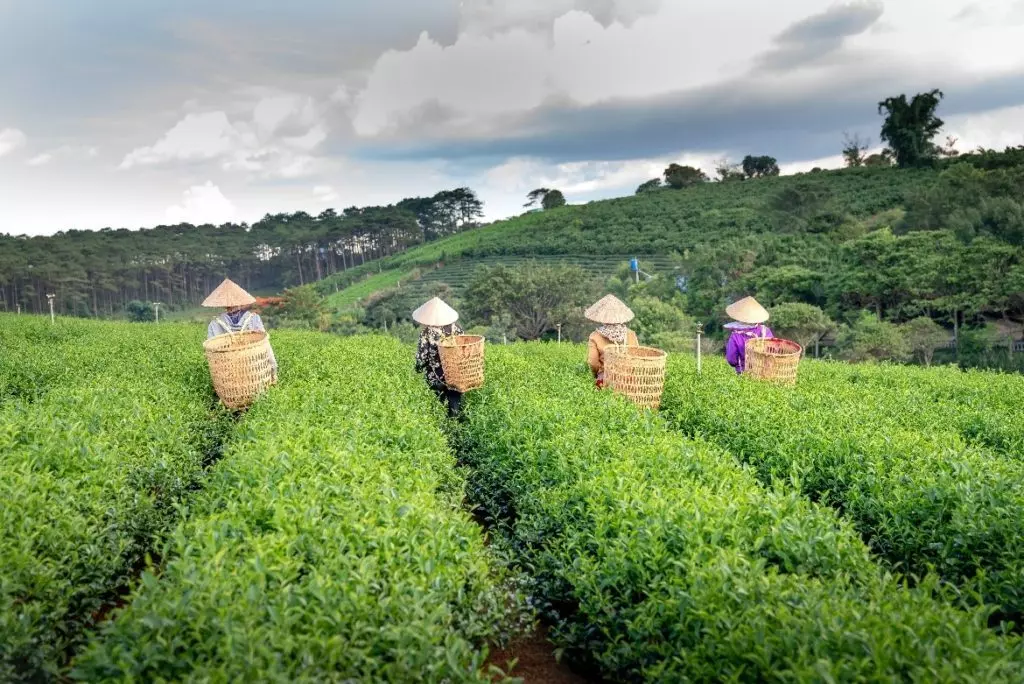
Organic Green Tea: History & Benefits
Thesis: The article explores the history, processing, and unique characteristics of organic green tea, the second most popular drink in the world, behind water, and highlights how it comes from a rare variant of the ubiquitous Camellia Sinensis plant called Camellia Taliensis, which grows in different regions of the world and offers different flavoring characteristics based on the surrounding vegetation.
The Essence of Green Tea
Mom used to have a Camellia Flower Bush out by the front porch, it was quite beautiful during bloom time. Nice aroma too. The flowers would often end up in a vase in the center of the table. Once a month, the gardener would come along and sheer the bushes to a symmetrical square shape, and the clippings of the leaves & flowers would fall to the ground. He would summarily rake them up to be hauled to a dumping place. Seemed a shame to cut off the flowers, so pretty and all. Looking back, I should’ve lamented the loss of the leaves. While the flower steals the show, it is the leaves from the Camellia Sinensis plant that tea, all tea, is made from.
Green Tea History
Turns out that organic green tea has been around for a long time. Originally discovered in ancient China (~2000 B.C) in the Southwest of the country near the Himalayas, tea was consumed by the locals (and the Yin Dynasty) as a medicinal drink. It finally became known to Western civilizations during the 16th Century when traveling Portuguese priests interacted with Chinese merchants. The British loved tea so much that, during the 17th century, they decided to commercialize production in India to compete with the Chinese monopoly on the product.
Today, organic green tea is enjoyed by millions of people worldwide and is the second most popular drink behind water. We drink it for the health benefits, the taste, and for social & ceremonial reasons. People drink hot and cold tea (my personal preference), with milk or sweetener or maybe even with those strange little “bubbles” offered now. Stay tuned for “Lubba Bubble Tea”. Hey, that rolls off the tongue nicely.
Today’s organic green tea is grown in many parts of the world, providing the right combination of growing conditions. Much of the tea we drink comes from higher elevations like that of the Assam region in Northeastern India, the Darjeeling region near Nepal, the Yunnan Province in China, the Jambi Province in Indonesia, the Alishan High Mountains in Taiwan, and our case, the mountains around Chiang Mai of Thailand.

Organic green tea harvesting in the mountains around Chiang Mai of Thailand.
These higher-elevation teas have complex flavoring characteristics that pick up tones from the unique neighboring vegetation. As one might expect, different growing regions result in different tasting attributes. Some teas are grown at lower elevations, like Japanese teas, which have a grassy, ocean flavor described as “umami”.
Green Tea Processing
There are several levels of “processing” that the Camellia Sinensis leaves can go through to make your favorite tea. This process ranges from the production of White to Black tea and everything in between. The simplest of these is White Tea. In this type, only the first-emerging, bud-like leaves are picked very early in their life cycle. Doesn’t seem right to pick those immature leaves before they’ve gotten a chance at life, but this is the age-old process of creating White Tea. White Tea’s yield is very small compared to other tea types (which explains the higher cost). These young leaves are then withered slightly, steamed to lock in the color and prevent further oxidization, then dried. Upon drying, little white hairs emerge, hence the “White Tea” moniker. The leaves are kept out of sunlight to lock in the unique flavors of this type..aaaand they’re delicious!
The next type of tea happens to be the most popular drink in the world besides water itself, and that is Organic Green Tea, which is the focus of this blog post. It just so happens that Lubba Tea Co has lots of this stuff. Our Green Tea has a very simple path to your cup as well. It is picked from a US Certified, Organically Grown tea plant high in the mountains of Thailand. This is done when the leaves are mature, sometimes called first flush, second flush, etc. Then the leaves are taken to a US Certified Organic Factory that is so clean that you could eat off the floors. Tea specialists, dressed in bright, clean white suits, take the leaves and ever-so-slightly roll them (not on the floor) to optimize the flavor. The leaves then undergo a steaming process to deactivate oxidative enzymes, which maintain the green color. Our method of choice for steaming is the technique of pan-frying steaming. It’s been around a while.

From there, the leaves go into a warm dryer, then straight into a Lubba Teabag. The next step should be a road trip to your table or favorite easy chair. You will need a steeper for your cup, however, as our tea is all loose leaf. We wouldn’t want our tea leaves crammed into an uncomfortable little tea bag.
While I noted earlier that all tea comes from the Camellia Sinensis plant, our Green Tea comes from a rare variant of this ubiquitous tea plant. It’s a cousin if you will, and it’s called Camellia Taliensis, whereby the leaves are a little larger, and the taste is a little sweeter. Our supply comes from a combination of old tea trees, some 100 years or more, and relatively new trees planted to perpetuate this rare species.
We’ve noticed that the aroma of a freshly opened bag of Lubba Green Tea is almost as wonderful as the taste of the tea itself. It’s amazing that an unaltered tea leaf can smell so sweet, but what a joy it is to take in a whiff of a freshly opened tea bag. Other types of green tea don’t smell quite this good. We think tea should look, smell, and taste good. We like to positively affect as many of those sensory attributes as possible, and we’re still trying to figure out how to get it to hear well. No luck so far.
Green Tea is consumed all over the world. The countries that consume the most tea, in general, are Turkey, Ireland, Iran, and the UK. The US ranks 35th in consumption of this wonderful drink. We aim to change that by getting people sipping on a nice hot cup of our special brand.
Here’s a fact that not many people know about. The greener the tea, the more caffeine. So Black Tea has less caffeine than Green Tea. Many people are cautious about their caffeine intake, but so that you know, the caffeine in Green Tea is different than that of coffee. It doesn’t spike you up, give you the jitters, then crash you down. Instead, Green Tea caffeine ramps you up slower, makes you nice and alert, then glides you back down.
Benefits of Green Tea
Green Tea may be the healthiest beverage on the planet. It’s been used for good health for millennia. Today is no different. Studies around the world have shown that Green Tea can be beneficial to your health. Green Tea is loaded with antioxidants that have been shown to improve brain function, help with fat loss, protect against cancer, reduce inflammation, fight against diabetes, and lower the risk of heart disease. It’ll help you grow taller, too…ok, that one might be a stretch.
One of the reasons green tea is so beneficial is that it is full of Polyphenols, which are natural compounds found in some types of plant foods like fruits, herbs, vegetables, spices, dark chocolate, and, of course, tea. Polyphenols can act as antioxidants, neutralizing those pesky free radicals that cause damage to your cells that could result in health maladies. Naturally occurring Polyphenols in plants are much more effective than supplements containing the compound, so don’t even think about popping a polyphenol pill, knock back some of our Green Tea and call it good.
Other natural antioxidants are also found in Green Tea, like (big word alert) “epigallocatechin-3-gallate”. Hey, let’s call that EGCG. EGCGs are Catechins that help prevent cell damage and are the most powerful compound in Green Tea. They beat-up free radicals that cause you to age prematurely and cause a disease or two.
Another interesting fact is that Green Tea possesses something called “L-Theanine.” This is an amino acid that can cross the blood-brain barrier. Not sure what that is, but it sounds important, so I put it in. L-Theanine increases the activity of GABA, which has anti-anxiety effects. This one should sound pretty cool to brain surgeons out there, L-Theanine increases dopamine and the production of Alpha waves in the brain. ..Geez, that’s reason enough to start drinking Green Tea right there! And the combination of caffeine and L-Theanine can synergistically affect brain function. So imagine this, you’ve got this big exam to take, and you desperately need to be alert AND calm simultaneously. Well, you’ve got the perfect tool in Green Tea.
Drinking Green Tea

Now that your health is squared away, let’s work on your breath. It just so happens that the same Catechins mentioned before help your oral health. There’s no evidence yet that Green Tea kills the cavity-making bacterium streptococcus mutans, but there is evidence that it may reduce bad breath. So now you can have great breath while scoring that “A.” And it’s all because you enjoyed a nice cup of Lubba Green Tea.
Leo Lubba.
“I’d Lubba Tea”

Recent Comments